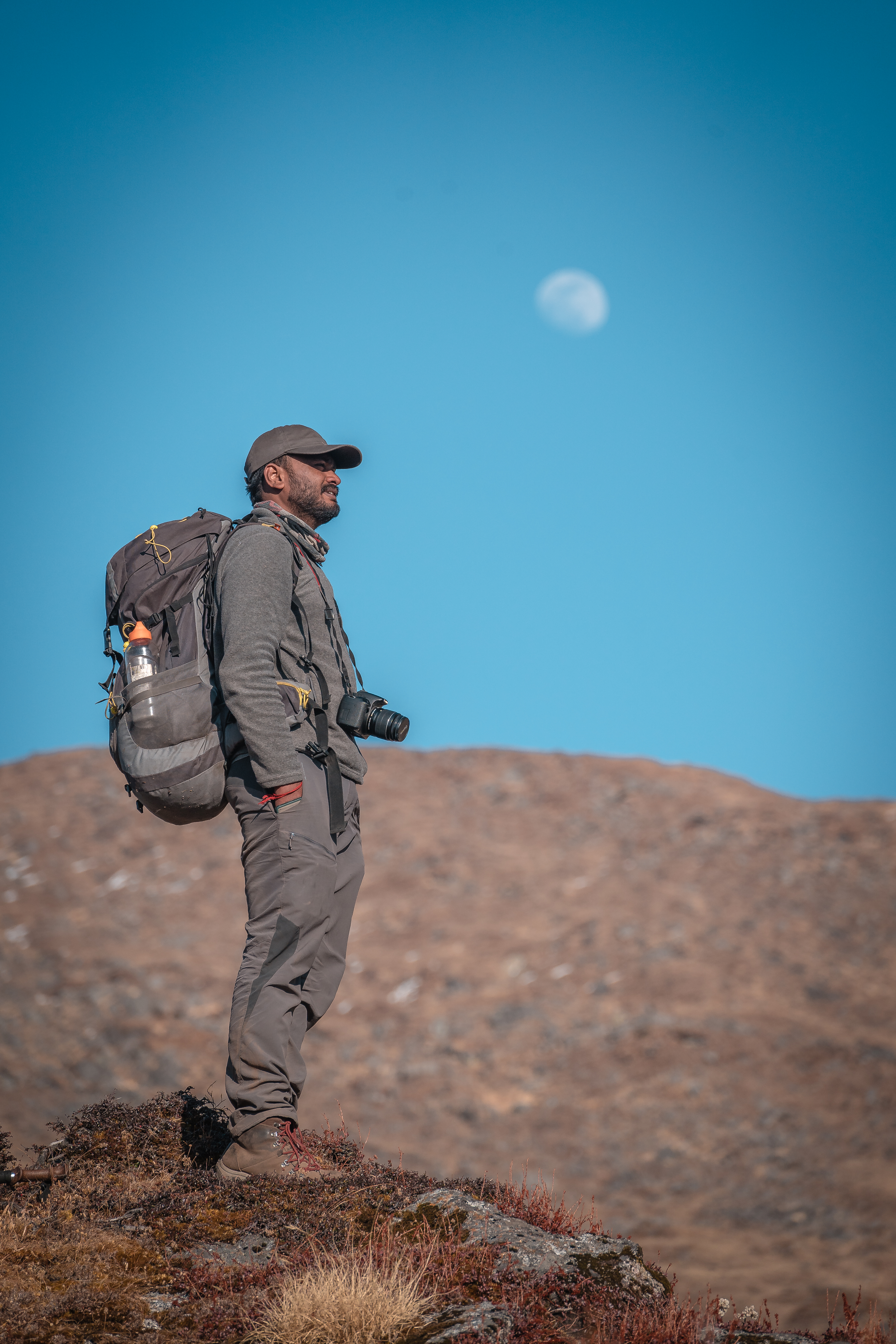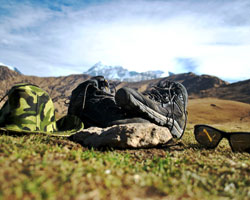Though we have categorized the Snow Leopard Expedition under the adventure category, the itinerary is very different from our usual treks and mountaineering expeditions. The very nature of the tour, trail, technique, and purpose differ from each other. If you are a trekker with an avid interest in wildlife viewing or if you are a wildlife enthusiast who is looking for a bit of challenge on the trail, knowing how the snow leopard expedition is different from our usual treks can come in handy.
The following are some key areas where the two differ from each other.
Campsites
Normal trek –
On treks, we know the locations of campsites for each day beforehand. These locations rarely change except during times of unpredictable weather conditions or technical issues like space and availability.
Snow leopard expedition–
On the snow leopard expedition, there are no fixed trails for each day. This means the campsites are not known beforehand. We may change campsites every day or not at all during the course of the expedition. The itinerary depends entirely on the viability of spotting the snow leopard in a particular area on a particular day. If the leader can scout, track and pinpoint a particular spot for the leopard, then we might shift the base camp near the designated point.
Statistics dictate that a snow leopard can stay in a spot for weeks if it gets a mating companion or for 3-4 days if it gets a kill. So calculations are made after taking all necessary factors like time and distance before a decision is made about a particular campsite.

Summit
Normal trek –
Oftentimes than not, the goal on treks usually is to touch the summit point (In circular treks, this is marked by the highest point/altitude one can reach). That's the ultimate point that gives complete satisfaction to people. It is constant. Though luck and weather play a little role in it, fitness is the major deciding factor. It's the standard measurement placed by nature to calculate our ability and will to reach there. Completing summit day gives us a feeling of accomplishment. After that, all that is left to do is return.
Snow leopard Expedition –
Everything is unpredictable on a Snow Leopard expedition. More than fitness, luck, and patience play a major role in it. The purpose here is to spot the unseen. People have stayed in Ladakh for several years and have never been able to spot even the tail of a snow leopard. On the other end, commoners visiting for a few days have gotten lucky enough to view the grey ghost from up close. The entire trek is like a quest for something mystic and exceptional. And the few who have seen a snow leopard will never compare that experience to a summit because this feeling is a different kind of other-worldly.

Trails
Normal trek –
On a normal trek, our route map is fixed. Days are spent moving from one campsite to the next while negotiating steep ascents and descents. The pathways are stable and well established. Also, our momentum never breaks when we walk. Since our main objective is to reach the next campsite, we keep moving ahead with small breaks.
Snow leopard expedition –
In a snow leopard expedition, there are no fixed routes. We can begin from any point and go anywhere else. There would be days when we would be required to walk long distances or spend time exploring an area for track marks. And on the other end, there would be days when all we do is sit still for 6-7 hours in one spot in sub-zero temperatures waiting for the leopard to make its appearance.

Time limit
Normal trek –
On a normal trek, the schedule runs as per the golden rule 7-8-9, tea at 7 am, breakfast at 8 am and departure by 9 am. The day then ends in the evening after reaching the campsite before sunset. The entire time is calculated according to the start point, endpoint, and the momentum of the trekkers.
Snow leopard expedition –
The time here runs parallel in two steps. Step one is the timeline the guide follows. He/she will wake up early or stay up late to look for tracks. If they find something good then they will contact the group and alert them. According to the leader’s direction, the group will then follow an impromptu schedule built by the leader.
Mannerisms
Normal trek –
Staying with the group, following the leader, maintaining a constant speed, moving to the mountainside or riverside in case of emergency, consuming nutritious food and drinking water regularly are a few mannerisms that every trekker is expected to stick to on a normal trek.
Snow leopard expedition –
Stillness, patience, silence, alertness, and attentiveness are few mannerisms one is expected to cultivate here.
Certainty
Normal trek –
In a regular trek, you can expect your schedule to go as per plan to a certain extent except during times of bad weather, terrain, unforeseen injuries, etc. There is a set pattern in terms of the place and scenery. You can research about these things beforehand or even indulge for a long time when you reach the source like a viewpoint, meadow, etc. The chance of missing a place or a moment is rare.
Snow leopard expedition –
In contrast, there is more to a Snow Leopard expedition. You don’t know what to expect beforehand when it comes to wildlife viewing. Here, a moment happens haphazardly out of nowhere. You will never know when you will see a life form in front of you. Here, the chance of spotting a leopard rarely happens. But the sensation of adventure and thrill will keep you alert and excited throughout your journey.
Dining
Normal trek –
Because of the exertion, a normal trek demands a time-bound schedule, it is important to get the right food/nutrition at the right time. So the timings for dining are fixed and one is required to wake up early and get to the dining tent on time.
Snow leopard expedition –
Dining in a Snow leopard trek is slightly different from the usual. Since the schedule is not fixed and there are going to be times when you have to spend an entire day at a particular viewpoint, walking back to the campsite to get food is not a feasible option. So food and snacks are often brought to where you are instead of the other way round.
Guide/Leader
Normal trek –
In normal treks, there will be a trek leader and a local guide. They have specialized skill sets like first aid administration, search and rescue, mountaineering, safety tactics, and many more that are useful in the trekking and mountaineering domain to lead a batch safely to the summit and back.
Snow leopard expedition–
On a snow leopard expedition as well, we have a trek leader and guide. But they have a different range of skillsets. Here, they are trained in tracking techniques, spotting techniques, the study of smell, photography, and many more that aid them with finding and documenting the wildlife around.

Carrying weights
Normal trek –
On a normal trek, if a trekker is not going for the offloading option, he or she has to carry their rucksack. Including the necessities and essentials, the rucksack would weigh anywhere between 10-15 kg. The only exception to this is the summit day (on some treks) when we are expected to carry only a day pack. You can keep your main bag in the tent and just carry your essentials like water and food to the Summit point and then come back to your campsite.
Snow leopard expedition –
On the snow leopard expedition, it is quite the opposite. All you need to carry are your essentials and binoculars each day. You don’t have to carry your rucksack everywhere you go.
Keeping all these differences aside, there is one aspect where the snow leopard expedition and normal treks share a commonality. And that is in the area of techniques.

Techniques
The techniques of both normal treks and Snow Leopard Expedition are more or less the same. Negating the physical toll, both the trails require negotiation of steep ascents/descents in extreme weather conditions. So, from footwork to layering, the same rules apply in both places.






